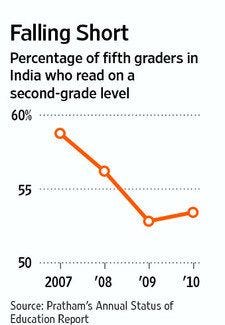India’s Education System – Corrupted, Inefficient, Dishonest and Failed?
India, unfortunately has become a country high on “symbolism” and “tokenism”. And this is generally known as “Getting the Stamp”. Therefore, there is a clamour to get in to the IITs. Since there were only 4 to begin with, and more couldn’t be created, the Government came to the help of the hapless, stamp-starved parents of kids. They arbitrarily ‘labeled’ many more who weren’t. Simply one day a college was called an IIT. To heck with the fact that IIT meant a certain quality of education and output.
This clamour for “stamps” has mushroomed thousands of Engineering colleges, which – it is said – the very mention of them have given sleepless nights to Barack Obama and his education groups. But are the thousands of “Engineers” coming out of these .. well.. “Stamp colleges” really Engineers? That is debatable. In fact in most cases not so.
Such is the ignominy of the graduates of such colleges that, in order to remain useful for job market, they go take computer programming classes at NIITs – local vocational institutes. The following claim shows the damning picture of India’s “Stamp Crazy” Education system.
Muddying the picture is that on the surface, India appears to have met the demand for more educated workers with a quantum leap in graduates. Engineering colleges in India now have seats for 1.5 million students, nearly four times the 390,000 available in 2000, according to the National Association of Software and Services Companies, a trade group.
But 75% of technical graduates and more than 85% of general graduates are unemployable by India’s high-growth global industries, including information technology and call centers, according to results from assessment tests administered by the group. (emphasis added)
The real import of these figures is that – we might as well have not opened these so-called Engineering colleges. Yes, the 75% of them!! If the NASSC’s figures are to be looked in light of the claim later, only 375k out of 1.5 million graduates are employable. Astounding 1.125 million students are paying a lot and studying hard to
become
unemployable! If that is not sick and unfortunate, what is?
The mess is not just confined to the higher education, even at the school level, the claims of literacy really mean nothing. See these results from a Pratham survey for example:
Another survey, conducted annually by Pratham, a nongovernmental organization that aims to improve education for the poor, looked at grade-school performance at 13,000 schools in rural areas in India, where more than 70% of the population resides. It found that about half fifth graders can’t read at a second-grade level in India.
If 50% of the school kids in rural areas are not even ready to read at 3 grade levels below their current levels, then where are they going? The gap will only increase as they go on.
Education Mess a Mirror of Society?
Make no mistake, the entire mess is symptomatic of the mess in the current society itself. The corruption of individuals at such deep levels that it is not even realized.
The worst thing that has happened is that somehow the “2k Issues” in the computer world, catapulted India’s then starved computer educated populace – well educated and world class, but without jobs – to world’s center stage. India became a brand. Brown man or woman was considered “God’s Gift” to Information Technology. In many cases, it was so. But like all generalizations, it was an exaggeration. And remains.
Once the stereotype was established and businesses moved their back offices and technology work “lock, stock and barrell” to India, it was considered a sign of lunacy to even argue against shifting work to India. In fact, today, even at the higher and senior level executives are afraid – yes, afraid – to even say that their Indian operations are not really working for them. They have to “make it work” – as it saves money for the shareholder, and legends say that it works!
Such easy success sponsored by world’s pussilanimity is breeding over-confidence now surely in the region of Superiority complex backed by little concrete. There is a strange sense of entitlement. Without the necessary effort or even scruples. Look at this case of cheating in an engineering college:
Mr. Singh and several other engineering graduates said they learned quickly that they needn’t bother to go to some classes. “The faculty take it very casually, and the students take it very casually, like they’ve all agreed not to be bothered too much,” Mr. Singh says. He says he routinely missed a couple of days of classes a week, and it took just three or four days of cramming from the textbook at the end of the semester to pass the exams.
Others said cheating, often in collaboration with test graders, is rampant. Deepak Sharma, 26, failed several exams when he was enrolled at a top engineering college outside of Delhi, until he finally figured out the trick: Writing his mobile number on the exam paper.
That’s what he did for a theory-of-computation exam, and shortly after, he says the examiner called him and offered to pass him and his friends if they paid 10,000 rupees each, about $250. He and four friends pulled together the money, and they all passed the test.
“I feel almost 99% certain that if I didn’t pay the money, I would have failed the exam again,” says Mr. Sharma.
You can bet that the case of Deepak Sharma is not a unique one. It is actually reflective of the unscrupulous system that we now find rampant in India at every level – from schools to colleges to even the highest echelons of the Government!
I was talking to a research visiting Professor from Chandigarh’s Punjab University today and she said something interesting. She said with a laugh that in Punjab “we usually have the Education Minister always an illiterate person. The Education Minister is the ONLY one who gets his salary not by signing but by putting his thumb impression!”. It may not always be a fact. But it is true. It is true from the systemic and knowledge stand point.
How to change this?
Some companies which are directly affected by this lack of properly educated masses are making investments. Like WIPRO has started a program – called Mission 10X – to train the teachers in using the correct pedagogy techniques in teaching the engineering students.
“Before, I didn’t take the students into consideration,” says Vishal Nitnaware, a senior lecturer in mechanical engineering at SVPM College of Engineering in rural Maharashtra state. Now, he says, he tries to engage them, so they’re less nervous to speak up and participate in discussions.
Instead of either standing with his back to the students and writing on the board or facing them but only to lecture – afraid of engaging – these teachers have just made one change – Engage the Students! That has brought a huge change to the level of how the students are responding to their classes.
Yogesh Nerkar, principal of PVG College of Engineering and Technology in Pune says attendance in his classes soared when he applied the techniques he learned in the workshops after participating in one in 2008. Nearly 90% of his students attended his classes last year, he says, a big increase from the 40% who used to show up under duress before he participated in the workshop. He says he’s put projectors in all classes so professors can use audiovisuals to explain diagrams instead of spending a big part of their time drawing on the blackboard.
“Before, I was just presenting my views in class. Students were not taking interest, but because we made attendance compulsory, some students would come,” he said in an interview in February.
More and more companies and private effort will need to be expended on the education system, if we have to improve the future of India.
If the future generations, brought up a sense of entitlement where they think they “own the future of the world” – have to come even close to their dreams, they will have to work very hard.
More importantly,
we
will have to work harder!





